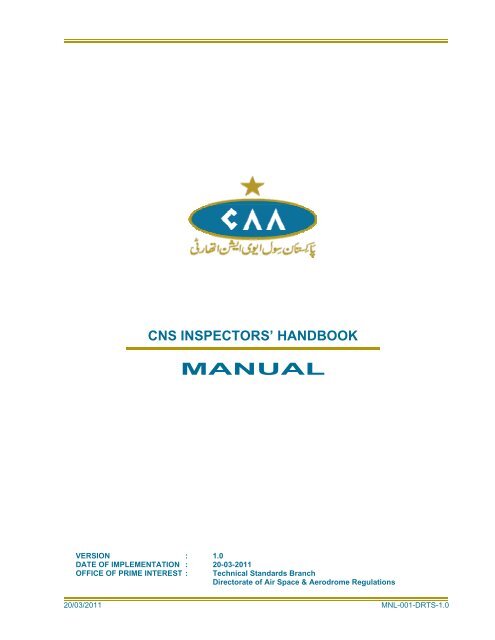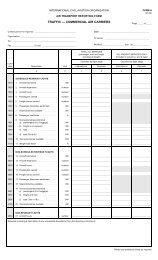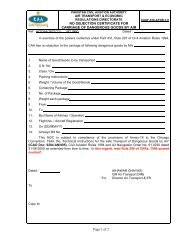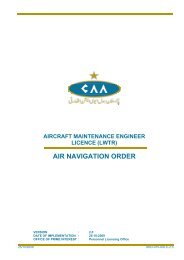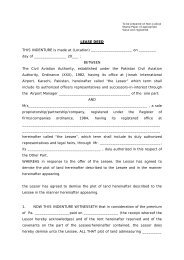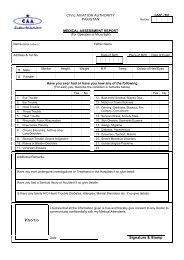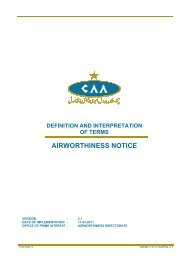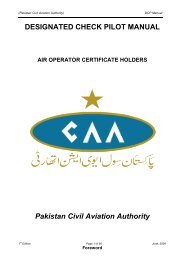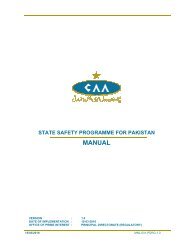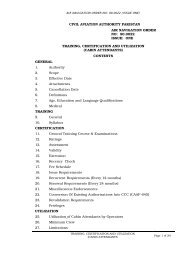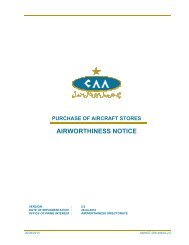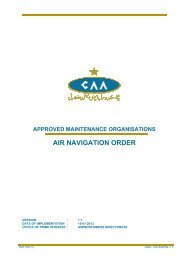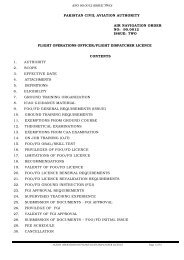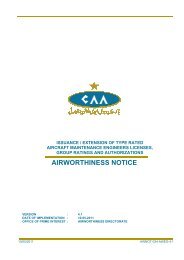MNL-001-DRTS-1 - Civil Aviation Authority
MNL-001-DRTS-1 - Civil Aviation Authority
MNL-001-DRTS-1 - Civil Aviation Authority
- No tags were found...
You also want an ePaper? Increase the reach of your titles
YUMPU automatically turns print PDFs into web optimized ePapers that Google loves.
CNS INSPECTORS’ HANDBOOKMANUALVERSION : 1.0DATE OF IMPLEMENTATION : 20-03-2011OFFICE OF PRIME INTEREST : Technical Standards BranchDirectorate of Air Space & Aerodrome Regulations20/03/2011 <strong>MNL</strong>-<strong>001</strong>-<strong>DRTS</strong>-1.0
CNS INSPECTORS’ HANDBOOKRECORDS OF AMENDMENTS AND CORRIGENDANo.AMENDMENTSDate DateApplicable EnteredCORRIGENDADateEntered by No. Date of IssueEnteredEnteredby20/03/2011 i <strong>MNL</strong>-<strong>001</strong>-<strong>DRTS</strong>-1.0
CNS INSPECTORS’ HANDBOOKTABLE OF CONTENTSFOREWORD ................................................................ iiiGLOSSARY OF TERMS ANDABBREVIATIONS/ACRONYMS................................... ivChapter 1 ................................................................... 1-1DEFINITIONS ........................................................................................................................... 1-1Chapter 2 ................................................................... 2-1GENERAL ................................................................................................................................. 2-12.1 INTRODUCTION: .................................................................................................. 2-12.2 STATUTORY AUTHORITY: ................................................................................. 2-12.3 FUNCTIONS OF TECH STANDARD BRANCH: .............................................. 2-12.4 WORKFORCE REQUIREMENT: ........................................................................ 2-22.5 POSITION OF CNS INSPECTOR: ..................................................................... 2-22.6 JOB DESCRIPTION: ............................................................................................. 2-22.7 PURPOSE OF INSPECTION: ............................................................................. 2-92.8 QUALIFICATION / CRITERIA FOR CNS INSPECTORS: ............................ 2-112.9 STATION TO BE INSPECTED: ......................................................................... 2-112.10 GOVERNING DOCUMENTS: ........................................................................ 2-11Chapter 3 ................................................................... 3-1INSPECTION PROCEDURES ............................................................................................... 3-13. 1 THE ROLE OF INSPECTORS: ........................................................................ 3-13. 2 PLANNING PREPARATION OF INSPECTION: ........................................... 3-13. 3 METHOD OF INSPECTION: ............................................................................ 3-13. 4 INTERVIEWS:..................................................................................................... 3-13. 5 INSPECTION SCHEDULE: .............................................................................. 3-2Chapter 4 ................................................................... 4-1TRAINING & PERSONAL ETHICS ....................................................................................... 4-14. 1 TRAINING OF INSPECTORS:......................................................................... 4-14. 2 PERSONAL ETHICS AND CONDUCT: ......................................................... 4-1APPENDICES ........................................................... A-1APPENDIX – “A” ....................................................... A-2CNS INSPECTION OBSERVATIONS ................................................................................. A-21 PEOPLE / PERSONNEL / STAFFING…….….A-22 PROCEDURE………………………………………………..………….……A-43 WORKING CONDITIONS………………………………….……..…….….A-1020/03/2011 ii <strong>MNL</strong>-<strong>001</strong>-<strong>DRTS</strong>-1.0
CNS INSPECTORS’ HANDBOOKGLOSSARY OF TERMS ANDABBREVIATIONS/ACRONYMSAFTN : AERONAUTICAL FIX TELECOMMUNICATION NETWORKAMHS : ATS MESSAGE HANDLING SYSTEMANO : AIR NAVIGATION ORDERANP : AIR NAVIGATION PLANASMP : AERODROME STANDARDS MANUAL PAKISTANATN : AERONAUTICAL TELECOMMUNICATION NETWORKATS : AIR TRAFFIC SERVICECARs : CIVIL AVIATION RULESCATI : CIVIL AVIATION TRAINING INSTITUTECNS : COMMUNICATION, NAVIGATION & SURVEILLANCECVOR : CONVENTIONAL VERY HIGH FREQUENCY OMNI RANGEDAAR : DIRECTORATE OF AIR SPACE AND AERODROMEREGULATIONSDGCAA : DIRECTOR GENERAL OF CIVIL AVIATION AUTHORITYDME : DISTANCE MEASURING EQUIPMENTDVOR : DOPPLER VERY HIGH FREQUENCY OMNI RANGEG.M : GENERAL MANAGERHQCAA : HEADQUARTERS CIVIL AVIATION AUTHORITYICAO : INTERNATIONAL CIVIL AVIATION ORGANIZATION.ILS : INSTRUMENT LANDING SYSTEMISO : INTERNATIONAL ORGANIZATION FOR STANDARDIZATIONJDs : JOB DESCRIPTIONSNDB : NON DIRECTIONAL BEACONNOTAM : NOTICE TO AIRMENOEM : ORIGINAL EQUIPMENT MANUFACTUREROJT : ON JOB TRAININGPCAA : PAKISTAN CIVIL AVIATION AUTHORITYSARPS : STANDARDS AND RECOMMENDED PRACTICESSOP : STANDARD OPERATING PROCEDURESSR : SECONDARY SURVEILLANCE RADARUHF : ULTRA HIGH FREQUENCYVHF : VERY HIGH FREQUENCY20/03/2011 iv <strong>MNL</strong>-<strong>001</strong>-<strong>DRTS</strong>-1.0
CNS INSPECTORS’ HANDBOOKChapter 1DEFINITIONS1.1 The following terms when used in this Hand book have the meanings assigned to themrespectively. Any term used in this document but not defined herein shall have the samemeaning as given in the <strong>Civil</strong> <strong>Aviation</strong> Ordinance, 1960, Pakistan <strong>Civil</strong> <strong>Aviation</strong> <strong>Authority</strong>Ordinance, 1982, <strong>Civil</strong> <strong>Aviation</strong> Rules, 1994 (CARs, 1994) and relevant Air Navigation Orders.1.1.1. Air Navigation Services: Services provided to air traffic during all phases of operationsincluding Air Traffic Management (ATM), Communications, Navigation and Surveillance(CNS), Meteorological services for air navigation (MET), Search and Rescue (SAR) andAeronautical Information Services (AIS).1.1.2. Approval: The formal act of approving a change submitted by a requestingorganization. This action is required prior to the proposed change being implemented.1.1.3. Assessment: An evaluation based on engineering, operational judgment and/oranalysis methods or an appraisal of procedures or operations based largely onexperience and professional judgment.1.1.4. ATM Service: A service for the purpose of Air Traffic Management.1.1.5. <strong>Authority</strong>: The <strong>Civil</strong> <strong>Aviation</strong> <strong>Authority</strong> established under section 3 of the Pakistan <strong>Civil</strong><strong>Aviation</strong> <strong>Authority</strong> Ordinance, 1982.1.1.6. Closing Meeting: A meeting of the inspection team and the representatives of theservice provider at the end of the inspection, the purpose of which is to provide theservice provider authorities with preliminary information on inspection findings andproposed recommendations to enable the service provider to start working on itscorrective action plan.1.1.7. Conformance: The state of meeting the requirements of a Standard.1.1.8. Corrective action: Action to eliminate the cause of a detected non-conformity or noncomplianceor other undesirable situation.Note: - Corrective action does not mean the action taken to restore a non-conformingsituation to a conforming situation. This is known as remedial action. If the root cause ofnon-conformity is not addressed then it is very likely that similar non-conformities willrecur).1.1.9. Corrective Action Plan: An action plan submitted to CAA by an audited/inspectedService Provider, detailing the proposed action the service provider to resolve identifieddeficiencies (safety concerns), on the basis of recommendations made by anaudit/inspection team. Implementation of the corrective action plan should bring theservice provider into full compliance with the provisions of the NationalRules/Regulations, conformance with or adherence to prescribed Standards andRecommended Practices (SARPs), procedures and good aviation safety practices.1.1.10. Deficiency: Lacking of something essential, imperfect, defective and if such hazardsallowed to exist within a system, result in a system deficiency.20/03/2011 1-1 <strong>MNL</strong>-<strong>001</strong>-<strong>DRTS</strong>-1.0
CNS INSPECTORS’ HANDBOOK1.1.11. Event: Any incident that occurs or a situation arises at a particular place during aparticular interval of time.1.1.12. Hazard: Conditions, object or activity with the potential of causing injuries to personnel,damage to equipment or structures, loss of material, or reduction of ability to perform aprescribed function.1.1.13. Hazard Identification: The process of determining what can happen, why and how.1.1.14. Human Factor: The factor pertaining to human’s capabilities, limitations, and behaviorsand its integration into the design of a system to enhance the safety performance.1.1.15. Human Performance: Human capabilities and performance limitations which have animpact on the safety and efficiency of aeronautical operations.1.1.16. Incident: An occurrence, other than an accident, associated with the operation of anaircraft, which affects or could affect the safety of operation.1.1.17. Inspection: The basic activity of an audit, which involves examination of the specificcharacteristics of the safety oversight programme/function.1.1.18. Inspection Activities: Those activities and procedures by which information is obtainedin order to verify that the inspected location/airport is in conformance with, or adherenceto, applicable Standards and Recommended Practices (SARPs), procedures describedin ANO-<strong>001</strong>-<strong>DRTS</strong>-1.0 to ANO-006-<strong>DRTS</strong>1.0 and CNS Inspectors Hand Book. Suchactivities may include, but are not limited to, interviews, observations, inspections, andthe review of files and documents.1.1.19. Inspection Report: A standardized means of reporting the inspection findings to thedesignated authorities.1.1.20. Inspector: A person trained and authorized to undertake oversight inspections/audits.1.1.21. Monitoring: The processes to check, supervise, observe critically, or record theprogress of an activity/function or system on a regular basis in order to identify change.1.1.22. Non-adherence: A deficiency in characteristic, documentation or procedure withrespect to a Recommended Practice, procedure, guideline or good aviation safetypractice.1.1.23. Non-compliance: A deficiency in characteristic, documentation or procedure withrespect to provisions of the Chicago Convention or a national regulation.1.1.24. Non-conformance: A deficiency in characteristic, documentation or procedure withrespect to an ICAO Standard.1.1.25. Opening meeting: A meeting of the inspection team and the representatives of theService provider to be audited/inspected before the commencement of the inspection,the purpose of which is to provide the Authorities with information on theaudit/inspection process and the scope of the audit/inspection.1.1.26. Operations Manual: A manual containing procedures, instructions and guidance, foruse by the operational personnel in the execution of their duties.1.1.27. Recommendation: Those controls that have the potential to mitigate a hazard or risk but have notyet been validated as a part of the system or its requirements.1.1.28. Regulation: The giving of authoritative direction to bring about and maintain a desireddegree of order.20/03/2011 1-2 <strong>MNL</strong>-<strong>001</strong>-<strong>DRTS</strong>-1.0
CNS INSPECTORS’ HANDBOOK1.1.29. Safety: Safety is the state in which the risk of harm to persons or of property damage isreduced to, and maintained at or below, an acceptable level through a continuingprocess of hazard identification and risk management. Safety may also be defined: as acondition in which the risk of harm or damage is limited to an acceptable level.1.1.30. Safety Directive (SD): A mandate from the <strong>Authority</strong>/DGCAA (Regulator) to ServiceProvider(s)/Operator(s) to take immediate corrective action to address a noncompliance/non-conformanceissue that creates a significant unsafe condition.1.1.31. Safety Circular (SC): A guidance and/or information from the Director General /Regulator forService Provider(s) and Operator(s), necessary to take appropriate measures regardingsafety-related issue(s).1.1.32. Safety Oversight: A function by means of which the <strong>Authority</strong> ensures effectiveimplementation of the National <strong>Aviation</strong> Legislation, Rules, safety-related Standards andRecommended Practices (SARPs) and associated procedures prescribed in the AirNavigation Orders/Manuals/Directives including amendments thereto; to meet theobligations as contained in the Annexes to the Convention on international <strong>Civil</strong> <strong>Aviation</strong>and related ICAO documents. Safety oversight also ensures that the national aviationindustry provides a safety level equal to, or better than, that defined by the SARPs.‐.‐.‐.‐.‐.‐.‐.‐.‐.‐.‐.‐.‐.‐‐.‐.‐.‐.‐.‐.‐.‐.‐.‐.‐.20/03/2011 1-3 <strong>MNL</strong>-<strong>001</strong>-<strong>DRTS</strong>-1.0
CNS INSPECTORS’ HANDBOOKChapter 2GENERAL2.1 INTRODUCTION:The Technical Standards branch has been setup under Directorate of Air Space & AerodromeRegulations (D. AAR) within Pakistan <strong>Civil</strong> <strong>Aviation</strong> <strong>Authority</strong> (PCAA) to perform the safetyoversight function in the field of Communication Navigation & Surveillance (CNS). This Manuali.e. CNS INSPECTORS’ HANDBOOK primarily deal with job and responsibilities of CNSInspectors. The CNS Inspectors have been appointed within Technical Standards Branch ofD.AAR and will carry out their duties as per the policies laid down in this manual. The Inspectorsshall oversight all aspects of CNS concerning services, procedures, method and functions ofCNS service provider and their applicability in accordance with ANO-<strong>001</strong>-<strong>DRTS</strong>-1.0, ANO-002-<strong>DRTS</strong>-1.0, ANO-003-<strong>DRTS</strong>-1.0 , ANO-006-<strong>DRTS</strong>-1.0 & two other ANOs that are undervetting/signature.2.2 STATUTORY AUTHORITY:Technical Standards Branch under D.AAR is organized as a component part of the PCAA. It isauthorized by the DG CAA to carry out all required Safety Oversight function in the field of CNS.Further DGCAA has authorized the CNS Inspectors to enter any place to which access isrequired for the purpose of exercising his/her powers under the Rule 4(2)(a) and (5) of <strong>Civil</strong><strong>Aviation</strong> Rules 1994.2.3 FUNCTIONS OF TECH STANDARD BRANCH:The Technical Standards Branch in DAAR has the mandate:2.3.1 To provide regulatory and safety oversight of CNS service providers. Such oversight isconducted through scheduled and non-scheduled audits and inspections of CNSfacilities and equipment.2.3.2 Monitoring of the national CNS services safety oversight; risk management processes;and contributing to the development of national/international CNS regulations, standards,policies and practices.2.3.3 To provide assistance to the locations and respective branches regarding explanation ofICAO standards/recommendation/guidance materials pertaining to CNS, Electrical andMechanical facilities, Rescue and fire fighting. This includes preparation of necessaryANOs, evaluation of SOPs/Manuals/TOs etc developed by the service providers beforeimplementation.2.3.4 Monitoring of the CNS Service Provider operations;2.3.5 Monitoring the training and Experience of technical staff deployed by service providers toinstall, maintain and operate CNS Systems.2.3.6 To provide manpower to Aerodrome standards Branch for such inspections pertaining toElectrical, Mechanical, Fire & Safety.2.3.7 Evaluating & processing the requests from service providers such as CNS Dte. ,Ops Dte& E/M Dte. for exemptions from prescribed standards and recommended practices;20/03/2011 2-1 <strong>MNL</strong>-<strong>001</strong>-<strong>DRTS</strong>-1.0
CNS INSPECTORS’ HANDBOOK2.3.8 Providing operational guidance and interpretations to various directorates regarding theapplication of Standards and Recommended Practices of ANOs, CARs, Annexes anddocuments of ICAO.2.3.9 Establishing and conducting the safety oversight audit and inspection program for CNSsystems and procedures to verify compliance with CARs, ANOs and related Annexesand documents of ICAO.2.3.10 Studying aviation related occurrence data, analyzing trends, identifying risk indicators,assessing risk and recommending control measures for the provision of safe CNSsystems.2.3.11 Providing subject matter expertise to HQ and Service providers, in addition to outsideagencies, organizations in general; and2.3.12 Ensuring availability of protected aeronautical radio spectrum free from harmfulinterference for the safe operation of civil aviation.2.4 WORKFORCE REQUIREMENT:Technical Standard Branch of D.AAR shall make available a sufficient number of Inspectors andtrade staff, as per work load requirement, enabling them to carry out oversight inspection of allinstallations of CNS Equipment & procedures, with qualification, experience & knowledge inrelated field as elaborated in Job Description.2.5 POSITION OF CNS INSPECTOR:Name of the OfficeTitle/ PositionServiceGroupSub GroupDirectorateReporting OfficerHQs Pakistan <strong>Civil</strong> <strong>Aviation</strong> <strong>Authority</strong>CNS InspectorTechnicalTechnical Standards BranchCommunication, Navigation and SurveillanceAir Space & Aerodrome RegulationsG.M. Technical Standards2.6 JOB DESCRIPTION:Following are the Job Descriptions of CNS Inspectors of Technical Standards Branch.20/03/2011 2-2 <strong>MNL</strong>-<strong>001</strong>-<strong>DRTS</strong>-1.0
CNS INSPECTORS’ HANDBOOKCIVIL AVIATION AUTHORITYJOB DESCRIPTIONCAAF-031-HRBS-1.0Technical Standards BranchJob Title: GM Technical Standards Pay Group: 10Unit: Technical Standards Branch Reports to: Director A.A.R.Location: AAR Directorate HQCAALast revision April, 2010Date:PART-IA. JOB SUMMARY• General Manager Technical Standards is responsible for Planning, Organizing, Leading and Controllingall the activities and functions of Technical Standards Branch pertaining to Communication, Navigation,Surveillance, Electrical, Mechanical and <strong>Civil</strong> works.• To supervise the oversight function being performed by Technical Inspectors of Technical StandardsBranch. To keep close coordination with the concerned Directorate & locations across Pakistan for theelimination of deficiencies being identified during inspections.B. PRIMARY RESPONSIBILITIES• Proper manning and readily availability of resources for the man-power (Officers and their staff) of thisBranch for their optimum performance. To regulate work load of the deployed man power under controlof G.M Tech. Standards and to advise D.AAR on issues such as revision/amendment of Organogram.• Formation of Standards for CAA Pakistan in various Engineering fields as CNS, E&M and <strong>Civil</strong> Worksin the form of Operating Regulations, ANOs or any other document. To ensure updating andimplementation of the devised Standards and to make sure that the standards formed in the form ofOperating Regulations, ANOs or any other document must be in line with ICAO SARPs.• Updating D.AAR on performance of Technical Standards Branch and to discuss and resolve any issuesrelating to functioning of this Branch.• To plan visits of Inspectors for the oversight function and ensure submission of report to concernquarters giving a suitable time line for removal of deficiencies.• To perform random checks /surprise visits of locations as part of oversight function to authenticate thesteps being taken by location for removal of deficiencies.• To explore and make arrangement for training of inspectors working in Technical Standards Branch andensure implementation of training program.• Ensure implementation of relevant directives and policy decision of HQCAA.• To assume any other responsibility that may contribute in the performance enhancement of TechnicalStandards Branch.C. SECONDARY / ADDITIONAL RESPONSIBILITIES• Any additional duties / responsibilities assigned by D.AAR.20/03/2011 2-3 <strong>MNL</strong>-<strong>001</strong>-<strong>DRTS</strong>-1.0
CNS INSPECTORS’ HANDBOOKCIVIL AVIATION AUTHORITYJOB DESCRIPTIONCAAF-031-HRBS-1.0Technical Standards BranchJob Title: CM Technical Standards (Com) Pay Group: 09Unit: Technical Standards Branch Reports to: GM Technical StandardsLocation: AAR Directorate HQCAALast revision April, 2010Date:PART-IA. JOB SUMMARY• To assist GM Technical Standards in preparation and subsequent approval/implementation of allnecessary ANOs, Operating Regulations and standard manuals.• To inspect digital data/ voice communication systems, communication circuits, their lay-out, proceduresat various International and Domestic Airports of Pakistan and utilization of radio frequencies in line withthe ANO-<strong>001</strong>-<strong>DRTS</strong>-1.0, ANO-003-<strong>DRTS</strong>-1.0, ANO-004-<strong>DRTS</strong>-1.0, ANO-006-<strong>DRTS</strong>-1.0 and <strong>MNL</strong>-<strong>001</strong>-<strong>DRTS</strong>-1.0.B. PRIMARY RESPONSIBILITIES• To establish monitoring system for checking that communication traffic is being handled in accordancewith the instructions contained in ANO-003-<strong>DRTS</strong>-1.0 and ANO-006-<strong>DRTS</strong>-1.0 and other instructionsissued from time to time.• To inspect various airports and ensure implementation of instructions contained in ANOs, Manuals andother documents.• To inspect local procedures at different airports for handling of communication traffic and suggestactions to minimize delays.• To observe and inspect communication equipment / Nav-Aids for the harmful interference of radiofrequencies.• To inspect for observing behavior / response of telephone operators on board at various airports andissue guidance / recommendations.• To inspect and ensure that every Airports has its own up-dated telephone directory in addition to theimportant telephone numbers of HQCAA and number to be used in case of emergency.C. SECONDARY / ADDITIONAL RESPONSIBILITIES• Any additional duties / responsibilities assigned by G. M. Tech. StandardsPART-IID. KNOWLEDGE AND SKILLPersonal Characteristics• Self starter with strong ambitions and dedication.• High level of integrity, motivation, and drive to have better results with interpersonal skill of communication.• Strong administrative skills such as decision making, organizing, and planning.Experience• Minimum 5 year in PG-09 in relevant field.• Minimum 15 years practical experience of various channels in communication centre/ Telephone Exchanges• Working experience of, locations and CATI.Educational Qualifications• Minimum Science graduate or a Professional degree from any recognized University in the field ofCommunication.• Basic Communication Officer Course from CATIWORKING CONDITIONSNormal office working conditions as prescribed by Directorate of QSHE CAA and acceptable to IMS CAA. Itis the responsibility of the Management to provide with resources to expect optimum output. Work mayrequire frequent traveling for purpose of inspections of CNS facilities and equipment across Pakistan.20/03/2011 2-5 <strong>MNL</strong>-<strong>001</strong>-<strong>DRTS</strong>-1.0
CNS INSPECTORS’ HANDBOOKCIVIL AVIATION AUTHORITYJOB DESCRIPTIONCAAF-031-HRBS-1.0Technical Standards BranchJob Title: CM Technical Standards (FDPS/RDPS) Pay Group: 09Unit: Technical Standards Branch Reports to: GM Technical StandardsLocation: AAR Directorate HQCAA Last revision Date: April, 2010PART-IA. JOB SUMMARY• To assist General Manager Technical Standards in preparation and subsequentapproval/implementation of all necessary ANO’s, guidance material and standard manuals as per therequirement of ICAO.• To observe and inspect Radar Area/Approach control centers/ATM equipment installed at variousairports of Pakistan to ensure smooth operation under the guidance provided as Standards andRecommended practices in ANOs and other related ICAO documents.B. PRIMARY RESPONSIBILITIES• To establish weekly/ fortnightly monitoring system of checking that Radar Area/Approach controlcenters/ATM equipment across the country are functioning properly in accordance with the instructionscontained in ANOs which are in line with ICAO Annexes and guidance material.• To inspect Radar Area/Approach/ATM equipment annually and submit report to G.M TechnicalStandards regarding operational status and deficiencies of ATM and Radar display equipment acrossPakistan.• To inspect local procedures/ SOPs at different locations related to maintenance of RadarArea/Approach centers/ATM equipment across Pakistan.C. SECONDARY / ADDITIONAL RESPONSIBILITIES• Any additional duties / responsibilities assigned by G. M. Tech. Standards.PART-IID. KNOWLEDGE AND SKILLPersonal Characteristics• Self starter with strong ambitions and dedication. Also motivator for junior team members.• Team player and respecting team's values.• Take the opportunity to teach and empower other team members.• Respect time and personal commitments of others.• A good listener and proactive in dealing with issues.• Be vigilant and give proper feedback as and when required.• The ability to establish connections with people.• High level of integrity, motivation, and drive to have better results.• Good analytical and interpersonal skills.• Strong administrative skills such as decision making, organizing, and planning.Experience• Minimum 05 years of working experience in PG-09 OR at least 15 years working experience of relevantfield in PG-08 in CAA.• Working experience of Headquarters, CATI and Location.Educational Qualifications• Graduate Engineer with major in Electronics OR Masters’ degree in Electronics/Physics.E. WORKING CONDITIONSNormal office working conditions as prescribed by Directorate of QSHE CAA and acceptable to IMS CAA. Itis the responsibility of the Management/Manager to provide with resources to expect optimum output. Workmay require traveling for purpose of inspections of Radar Area/Approach control centers/ATM equipmentacross Pakistan.20/03/2011 2-6 <strong>MNL</strong>-<strong>001</strong>-<strong>DRTS</strong>-1.0
CNS INSPECTORS’ HANDBOOKCIVIL AVIATION AUTHORITYJOB DESCRIPTIONCAAF-031-HRBS-1.0Technical Standards BranchJob Title: CM Technical Standards (Nav-Aids) Pay Group: 09Unit: Technical Standards Branch Reports to: GM Technical StandardsLocation: AAR Directorate HQCAA Last revision Date: April, 2010PART-IA. JOB SUMMARY• To assist General Manager Technical Standards in preparation and subsequentapproval/implementation of all necessary ANOs, guideline material and standard manuals as per therequirement of ICAO.• To observe and inspect Navigational equipment installed at various International Airports of Pakistan toensure smooth operation under the guidance provided as Standards and Recommended practices inANO-002-<strong>DRTS</strong>-1.0.B. PRIMARY RESPONSIBILITIES• To establish weekly/ fortnightly monitoring system of checking that Navigational Aids and Landing Aidsacross the country are functioning properly in accordance with the instructions contained in ANO-002-<strong>DRTS</strong>-1.0, CNS Operating Regulations & CNS Manual.• To inspect Navigational/Landing Aids at various airports/locations and submit report to G.M TechnicalStandards regarding operational status and deficiencies.• To inspect local procedures/SOPs at different airports/location for maintenance of Navigational/LandingAids across Pakistan.C. SECONDARY / ADDITIONAL RESPONSIBILITIES• Any additional duties / responsibilities assigned by G. M. Tech. StandardsD. KNOWLEDGE AND SKILLPersonal Characteristics• Self starter with strong ambitions and dedication. Also motivator for junior team members.• Team player and respecting team's values.• Take the opportunity to teach and empower other team members.• Respect time and personal commitments of others.• A good listener and proactive in dealing with issues.• Be vigilant and give proper feedback as and when required.• The ability to establish connections with people.• High level of integrity, motivation, and drive to have better results.• Good analytical and interpersonal skills.• Strong administrative skills such as decision making, organizing, and planning.Experience• Minimum 05 years of working experience in PG-09 OR at least 15 years working experience in PG-08 inCAA.• Working experience of CATI and Location.Educational QualificationsGraduate Engineer with major in Electronics OR Masters’ degree in Electronics/Physics.E. WORKING CONDITIONSNormal office working conditions as prescribed by Directorate of QSHE CAA and acceptable to IMSCAA. It is the responsibility of the Management to provide with resources to expect optimum output.Work may require frequent traveling for purpose of inspections of Navigational/Landing Aids acrossPakistan.20/03/2011 2-7 <strong>MNL</strong>-<strong>001</strong>-<strong>DRTS</strong>-1.0
CNS INSPECTORS’ HANDBOOKCIVIL AVIATION AUTHORITYJOB DESCRIPTIONCAAF-031-HRBS-1.0Technical Standards BranchJob Title: CM Technical Standards (Surv) Pay Group: 09Unit: Technical Standards Branch Reports to: GM Technical StandardsLocation: AAR Directorate HQCAA Last revision Date: April, 2010PART-IA. JOB SUMMARY• To assist General Manager Technical Standards in preparation and subsequentapproval/implementation of all necessary ANOs, guideline material and standard manuals as per therequirement of ICAO• To observe and inspect RADAR & Extended Range VHF equipment installed across Pakistan to ensuresmooth operation under the guidance provided as Standards and Recommended practices in ANO-005-<strong>DRTS</strong>-1.0.B. PRIMARY RESPONSIBILITIES• To establish monitoring system of checking that Surveillance (RADAR) and Extended Range VHFequipment across the country are functioning properly in accordance with the instructions contained inANO-005-<strong>DRTS</strong>-1.0.• To inspect Radar / EVHF locations annually and submit the report to G.M Technical Standardsregarding operational status and deficiencies of RADAR and Extended Range VHF equipment acrossPakistan.• To inspect local procedures/ SOPs at different RADAR/ EVHF locations related to maintenance ofRADAR and Extended Range VHF equipment across Pakistan.C. SECONDARY / ADDITIONAL RESPONSIBILITIES• Any additional duties / responsibilities assigned by G. M. Tech. StandardsPART-IID. KNOWLEDGE AND SKILLPersonal Characteristics• Self starter with strong ambitions and dedication. Also motivator for junior team members.• Team player and respecting team's values• Take the opportunity to teach and empower other team members.• Respect time and personal commitments of others.• A good listener and proactive in dealing with issues• Be vigilant and give proper feedback as and when required.• The ability to establish connections with people• High level of integrity, motivation, and drive to have better results.• Good analytical and interpersonal skills.• Strong administrative skills such as decision making, organizing, and planningExperience• Minimum 5 year of working experience in PG-09 OR at least 15 years working experience of relevantfield in PG-08 in CAA.• Working experience of CATI and Location.Educational Qualifications• Graduate Engineer with major in Electronics OR Masters’ degree in Electronics/Physics.E. WORKING CONDITIONSNormal office working conditions as prescribed by Directorate of QSHE CAA and acceptable to IMS CAA. Itis the responsibility of the Management/Manager to provide with resources to expect optimum output. Workmay require frequent traveling for purpose of inspections of Navigational/Landing Aids across Pakistan.20/03/2011 2-8 <strong>MNL</strong>-<strong>001</strong>-<strong>DRTS</strong>-1.0
CNS INSPECTORS’ HANDBOOK2.7 PURPOSE OF INSPECTION:The primary objectives of safety oversight inspections are to observe and assess the ServiceProvider’s adherence to standards and recommended practices related to Communication,Navigation and Surveillance (CNS) equipment and facilities described in Air Navigation Orders(ANO <strong>001</strong>-<strong>DRTS</strong>-1.0 TO ANO OO6-<strong>DRTS</strong>-1.0), National <strong>Aviation</strong> Legislation, <strong>Civil</strong> <strong>Aviation</strong>Rules-1994, OEM recommended maintenance and operating procedures, OEM Manuals,Directives and other related documents.2.7.1 INSPECTORS’ PRE-REQUISITS:Inspectors should have:2.7.1.1 Basic skills & knowledge required to participate as a team member in aninspection.2.7.1.2 Able to write an inspection findings accurately.2.7.1.3 Able to establish sound inspection follow up practices, including postinspection surveillance.2.7.2 INSPECTION STEPS:The inspection conducted by CNS Inspector in the steps elaborated as per follows:2.7.2.1 CNS Inspectors shall prepare inspection schedules and conduct periodicinspections of CNS procedures, equipment and facilities at least once in ayear to ensure that the physical characteristics, performance andmaintenance of the CNS facilities meet the standards and recommendedpractices described in ANOs issued by Tech. Standard Br. DAAR.2.7.2.2 CNS Inspectors shall conduct inspections and prepare reports fairly,truthfully and accurately with due professional care applying diligence andjudgment. They shall remain impartial and objective with an evidence-basedsystematic process to reach reliable conclusions.2.7.2.3 CNS Inspectors shall prepare inspection report and highlight the deficiencies(if any) along with suggested corrective actions to remove deficiencies andsubmit the same to DAAR through GM (TS) for approval.2.7.2.4 CNS Inspectors shall forward deficiencies noted to service provider(s) forsubmission of corrective action plan.2.7.2.5 Service providers’ corrective actions should be as per follows:2.7.2.5.1 IMMEDIATE: Taken immediately upon identification of theinspection finding to remove an immediate threat to aviationsafety2.7.2.5.2 SHORT TERM: To correct a non-conformance that does notpose an immediate threat to aviation safety. Normallyimplemented within 30 days2.7.2.5.3 LONG TERM: Identifying the cause of the problem andindicating the measures, service provider will take to prevent arecurrence. A timetable for implementation, normally within threesixty days.20/03/2011 2-9 <strong>MNL</strong>-<strong>001</strong>-<strong>DRTS</strong>-1.0
CNS INSPECTORS’ HANDBOOK2.7.3 OVERSIGHT FUNTIONS:The following oversight functions will be covered during inspection in the respectivefields:2.7.3.1 To ensure that CNS service provider adopted policies and procedures onhuman factors principle deployed experienced, qualified and having thecapabilities to accomplish the wide range of safety oversight activities.2.7.3.2 To ensure that CNS service provider has developed policy and proceduresfor determining the capacity of CNS system, including the number of staffrequired to ensure the provision of an adequate CNS system.2.7.3.3 To ensure that CNS provider has developed the job description for itstechnical staff.2.7.3.4 To ensure that CNS service provider has developed training programincluding refresher training for CNS staff.2.7.3.5 To ensure that CNS service provider has maintained training records or filesfor its CNS staff.2.7.3.6 To ensure that CNS service provider has developed requiredmaintenance/operational SOPs’ for CNS facilities.2.7.3.7 To ensure that CNS service provider maintain the corrective/preventivemaintenance data of CNS equipment.2.7.3.8 To ensure that procedure developed by CNS Service provider for continuedcompetency of in new CNS equipment, procedures and updatedcommunication.2.7.4 DUTIES OF CNS INSPECTOR:CNS inspectors will update the Inspector handbook and other guidance material for thelocation/airport to be inspected in the light of suggestions/ recommendation receivedfrom time to time.2.7.4.1 CNS inspectors will examine and analyze the operational manuals, SOPs,instructions, circulars and similar documents prepared or issued by the CNSservice provider that affect the performance and maintenance of CNSfacilities.2.7.4.2 CNS inspectors will actively guide and assist the CNS stations in preparingand developing procedures and documents.2.7.4.3 CNS Inspectors will initiate to amend ANO-<strong>001</strong>-<strong>DRTS</strong>-1.0 and related ANOsfrom time to time for compliance with ICAO Annexes (if required).2.7.4.4 CNS Inspectors will follow-up the corrective actions of stations tomitigate/eliminate the deficiencies.2.7.4.5 CNS Inspectors will participate in CNS related seminars, workshops andsymposiums.2.7.4.6 CNS Inspectors will develop, implement and keep records of trainingprograms for CNS inspectors.2.7.4.7 CNS Inspectors will maintain separate files for each station regarding itsinspection, observation / recommendations and follow ups.2.7.4.8 CNS Inspectors will carry out any other duty as assigned by the Director Airspace & Aerodrome Regulations / GM Technical Standards from time to timeon surveillance/oversight functions.20/03/2011 2-10 <strong>MNL</strong>-<strong>001</strong>-<strong>DRTS</strong>-1.0
CNS INSPECTORS’ HANDBOOK2.8 QUALIFICATION / CRITERIA FOR CNS INSPECTORS:2.8.1 CNS inspector should have extensive academic and technical education as described inJob Description (JDs) of Technical Standards Branch, and have progressed throughpositions of increased technical and supervisory responsibility in the organization. A CNSinspector will be required to have the following qualifications and professionalexperience:2.8.1.1 Certificate courses on Nav-Aids, Surveillance equipment and courses onCommunication Operation from <strong>Civil</strong> <strong>Aviation</strong> Training Institute (CATI)Hyderabad.2.8.1.2 Knowledge and expertise in the field of maintenance or operations of CNSfacilities as described in JDs of Technical Standards Branch.2.8.1.3 Good verbal and writing skills in English, proficiency in preparing manualsand documents, and skills in operating computers and word processing.2.8.1.4 Adequate knowledge in CNS related Air Navigation Orders, ICAO SARPsand other relevant documents.2.8.1.5 Personality to win the respect and confidence of the operators. This wouldrequire a reasonable level of tact, understanding, firmness, impartiality,integrity and an exemplary personal conduct both in the office and at theOperator’s premises.2.9 STATION TO BE INSPECTED:2.9.1 CNS inspectors will carry out inspections and safety oversight functions at the followingoffices/stations:2.9.1.1 CNS facilities operated and maintained at all the civil airports/locations inPakistan.2.9.1.2 CNS maintenance units at the Electronic Engineering Depot, Karachi.2.9.1.3 <strong>Civil</strong> <strong>Aviation</strong> Training Institute, Hyderabad.2.10 GOVERNING DOCUMENTS:2.10.1 ANO-<strong>001</strong>-<strong>DRTS</strong>-1.0 on Communication, Navigation & Surveillance2.10.2 CNS ANOs2.10.2.1 ANO-002-<strong>DRTS</strong>-1.0 on Nav-Aids2.10.2.2 ANO-003- <strong>DRTS</strong>-1.0 on Communication Procedures2.10.2.3 ANO-004-<strong>DRTS</strong>-1.0 on Communication System-Digital & Voice2.10.2.4 ANO-005- <strong>DRTS</strong>-1.0 on Surveillance and Collision Avoidance Systems2.10.2.5 ANO-006-<strong>DRTS</strong>-1.0 on Frequency Spectrum Utilization2.10.3 Other relevant directives and instructions that may be issued from time to time by theICAO / DGCAA or the Director AAR.20/03/2011 2-11 <strong>MNL</strong>-<strong>001</strong>-<strong>DRTS</strong>-1.0
CNS INSPECTORS’ HANDBOOKChapter 3INSPECTION PROCEDURES3. 1 THE ROLE OF INSPECTORS:3.1.1 The tasks to be undertaken by each inspector will be assigned by the GM TechnicalStandards / DAAR. These tasks may include conducting interviews of various officials ofthe unit, section or division being inspected, reviewing documentation, observingoperational status of equipment, maintenance procedures and taking observations forpreparation of inspection report.3. 2 PLANNING PREPARATION OF INSPECTION:3.2.1 A formal notification of intention to perform the inspection should be forwarded to theoffice to be inspected well in advance to provide adequate time for necessarypreparations for the office to be inspected. This notification should specify:3.2.1.1 The unit, section or division to be inspected;3.2.1.2 The authority under which the inspection is conducted;3.2.1.3 The proposed schedule;3.2.1.4 The overall purpose of the inspection and the scope of the topics to bediscussed;3.2.1.5 The detail of officials required for interview by the inspection team and therelevant documents.3.2.1.6 The inspection team members.3. 3 METHOD OF INSPECTION:3.3.1 The techniques for gathering the information on which the inspection team’s assessmentwill be made include:3.3.1.1 Review of documentation,3.3.1.2 Interviews with CNS maintenance / operation officicals, and3.3.1.3 Observations by the inspector.3.3.2 The inspection team should work systematically through the items on the relevant pointseach and every observation should be noted. .3. 4 INTERVIEWS:3.4.1 The principal way in which inspectors obtain information about the functioning of thesystems is by asking question.20/03/2011 3-1 <strong>MNL</strong>-<strong>001</strong>-<strong>DRTS</strong>-1.0
CNS INSPECTORS’ HANDBOOK3.4.2 The persons to be interviewed should be drawn from a range of management/supervisory operational positions.3.4.3 The purpose of inspection interviews is to elicit information, not to enter into discussions.3.4.4 All Inspectors should observe the following guidelines relating to the conduct ofinspection interviews:3.4.4.1 Listen attentively and let the speaker know you are listening.3.4.4.2 Ask ‘W’ questions – what, why, where, when, who, and how- these are thekey words that will bring forward facts and information.3.4.4.3 Remain neutral. Do not disagree, criticize or interrupt.3. 5 INSPECTION SCHEDULE:3.5.1 A tentative schedule for inspection of CNS facilities shall be prepared in the beginning ofthe each year and got approved by the DAAR. Inspector shall conduct safety oversightinspection work in CNS facilities at least once a year surprise surveillance inspections tobe carried as and when required.3.5.2 SUBMISSION OF REPORT:3.5.2.1 Inspection report shall be submitted to the Director Airspace & AerodromeRegulations through GM Technical Standards within seven (07) workingdays of conduct of inspection.20/03/2011 3-2 <strong>MNL</strong>-<strong>001</strong>-<strong>DRTS</strong>-1.0
CNS INSPECTORS’ HANDBOOKChapter 4TRAINING & PERSONAL ETHICS4. 1 TRAINING OF INSPECTORS:4.1.1 Initial and specialized training shall be arranged for CNS Inspectors to perform safetyoversight function efficiently.4.1.2 Since the responsibility of Inspectors is mainly implementing the civil aviationrequirement and various rules and orders, their knowledge on the subject must becurrent, as such a periodic recurrent of the same is considered imperative. Suchrefresher course should be programmed at least once in a year.4.1.3 The new Inspectors in the area of CNS will undergo On Job Training (OJT). The OJTshall be conducted by an experienced and trained CNS inspector in the following threephases:4.1.3.1 Phase 1: The New inductee inspector will accompany CNS inspectors’ teamas an observer. He will only observe inspection activities of CNS Inspectors.4.1.3.2 Phase 2: The inductee/OJT inspector will inspect/audit the CNSfacilities/procedure under supervision of a CNS inspector. He will preparereport for supervisor inspector.4.1.3.3 Phase 3: The OJT inspector will conduct inspection /audit independently,prepare and submit report to G.M Tech. Standard for further action.4. 2 PERSONAL ETHICS AND CONDUCT:4.2.1 As Inspectors are always in the public eye, they are expected to exercise good judgmentand professional behavior at all times while on or off duty.4.2.2 All Inspectors must observe the following rules of conduct:4.2.2.1 Report for work on time and in a condition that will permit performance ofassigned duties4.2.2.2 Maintain a professional appearance, as appropriate, during duty hours.4.2.2.3 Respond promptly to directions and instructions received from G.MTechnical Standards/DAAR.4.2.2.4 Exercise courtesy and tact in dealing with co-workers and with superiors.20/03/2011 4-1 <strong>MNL</strong>-<strong>001</strong>-<strong>DRTS</strong>-1.0
CNS INSPECTORS’ HANDBOOKAPPENDICES20/03/2011 APP. A-1 <strong>MNL</strong>-<strong>001</strong>-<strong>DRTS</strong>-1.0
CNS INSPECTORS’ HANDBOOKAPPENDIX – “A”CNS INSPECTION OBSERVATIONSStation Date Time InspectorsUse the following abbreviations wherever possibleY = Yes N = No NA = Not ApplicableS = Satisfactory U = Unsatisfactory NC = Not Checked1. PEOPLE / PERSONNEL / STAFFING1.1 Is the station organized and staffed well as required to carry out the CNS maintenance andoperational works?Review organizational setup and duty roster.Findings:Corrective actions:Comments:1.2 Has the station developed job descriptions for its technical / operational staff?Review operational manual or relevant documents.Findings:Corrective actions:Comments:1.3 Is minimum required number of staff available in the unit?Review list of existing number of employees.Findings:Corrective actions:Comments:20/03/2011 APP. A-2 <strong>MNL</strong>-<strong>001</strong>-<strong>DRTS</strong>-1.0
CNS INSPECTORS’ HANDBOOK1.4 Are all the maintenance / operational control positions properly manned?Visit the key operational control and monitoring positions.Findings:Corrective actions:Comments:1.5 Are the technical and operational personnel of the station adequately trained?Review training history and future training plans.Findings:Corrective actions:Comments:1.6 Whether station has realized / assessed future training requirement for their operational/technical staff?Review training history and future training plans.Findings:Corrective actions:Comments:1.7 Does the station maintain a record of training provided to its technical / operational staff?Update training record and future training plans.Findings:Corrective actions:Comments:1.8 Do the CNS operational / maintenance officials work beyond their normal duty timing?Review duty roster logbooks.Findings:Corrective actions:Comments:20/03/2011 APP. A-3 <strong>MNL</strong>-<strong>001</strong>-<strong>DRTS</strong>-1.0
CNS INSPECTORS’ HANDBOOK1.9 Whether the bad practices have been developed among CNS staff which are safety hazards ormight lead to safety hazards? (Example: using mobile phones, reading papers/books, listening toradios, watching TVs while working. Not following standard procedures and using shortcuts etc.)Findings:Corrective actions:Comments:1.10 Does the station have established training requirements for its technical/ Operational staff?Findings:Corrective actions:Comments:2. PROCEDURE:2.1 Whether the station has maintenance / operational manuals and standard operating proceduresfor maintenance of CNS systems / facilities?Review maintenance manuals and SOPsFindings:Corrective actions:Comments:2.2 Whether the station has related ANOs Technical Orders, guidance documents and standardoperating procedures etc for operational activities?Findings:Corrective actions:Comments:2.3 Does the station keep ANOs, manuals, circulars and guidance material in a way so that there isan easy access to those documents for each CNS official?Check the technical library, document keeping system.Findings:Corrective actions:Comments:20/03/2011 APP. A-4 <strong>MNL</strong>-<strong>001</strong>-<strong>DRTS</strong>-1.0
CNS INSPECTORS’ HANDBOOK2.4 Has the station established a system and procedures to incorporate/ amend its documents intimely manner?Check the technical library, document keeping system.Findings:Corrective actions:Comments:2.5 Does each unit engaged in CNS operations have its own standard operational procedures?(Example: SOP for ECR, Navigation Aids, Radar, Transmitting Station, AMHS, CommunicationProcedures etc.)Review section level SOPs.Findings:Corrective actions:Comments:2.6 Does each unit responsible for maintaining certain CNS system have all maintenance manualsfrom the original manufacturer of the system?Review factory provided maintenance manuals.Findings:Corrective actions:Comments:2.7 Does the station maintain proper records/logbooks for their CNS facilities?Review logbooks.Findings:Corrective actions:Comments:2.8 Does each CNS maintenance unit have proper system maintenance schedule and formsconforming to manufacturer’s manual / SOPs?Review performance check forms and manuals.Findings:Corrective actions:Comments:20/03/2011 APP. A-5 <strong>MNL</strong>-<strong>001</strong>-<strong>DRTS</strong>-1.0
CNS INSPECTORS’ HANDBOOK2.9 Does each CNS maintenance unit perform system maintenance checks as per schedule andforms conforming to the manufacturer’s manual?Review maintenance history.Findings:Corrective actions:Comments:2.10 Does the station have all cable lay-out diagrams of its CNS facilities?Review cable lay-out diagrams.Findings:Corrective actions:Comments:2.11 Does the station have suitable secondary power supply system?Check for provisioning and serviceability of secondary power supply system.Findings:Corrective actions:Comments:2.12 Does each CNS system have proper battery back up?Check for provisioning and serviceability of battery backup system.Findings:Corrective actions:Comments:2.13 Is every unmanned CNS system room/shelter inspected by technical staff according to standardprocedure?Inspect the places and review logbooks.Findings:Corrective actions:Comments:20/03/2011 APP. A-6 <strong>MNL</strong>-<strong>001</strong>-<strong>DRTS</strong>-1.0
CNS INSPECTORS’ HANDBOOK2.14 Does the station have flight calibration procedures for its Nav. Aids?Review relevant documents.Findings:Corrective actions:Comments:2.15 Has the station established a mechanism for review and elimination of deficiencies identified byCNS inspectors?Review relevant documents.Findings:Corrective actions:Comments:2.16 Does the station have remote status information display of navigation aids in equipment controlroom and respective ATS control centers? If not, what procedure is followed to inform ATS unitsof the navigation aids’ operating status?Check and review relevant documents and procedures.Findings:Corrective actions:Comments:2.17 Does the station analyze performance of CNS systems and communication channels?Check and review relevant documents and procedures.Findings:Corrective actions:Comments:2.18 Does the station (promptly/ regularly) report information on system performance to theHeadquarter?Check and review relevant documents.Findings:Corrective actions:Comments:20/03/2011 APP. A-7 <strong>MNL</strong>-<strong>001</strong>-<strong>DRTS</strong>-1.0
CNS INSPECTORS’ HANDBOOK2.19 Does the station have any mechanism for assessing, monitoring and evaluating the time takenfor responding to system failures that occurred?Findings:Corrective actions:Comments:2.20 Does the station have policy for retention of Radar data and records of ATS voicecommunications?Check for policy and actual retention of data.Findings:Corrective actions:Comments:2.21 Does the station properly maintain the monitor thresholds in navigation equipments?Check flight calibration report and check monitor on random basis.Findings:Corrective actions:Comments:2.22 Do the aerodrome markings for holding points meet the required criteria to safeguard thesensitive and critical areas of navigation aids?Check the taxiway marking points.Findings:Corrective actions:Comments:2.23 Does the station have redundant mast lighting system (obstruction indicators) over CNS systemantennas?Findings:Corrective actions:Comments:20/03/2011 APP. A-8 <strong>MNL</strong>-<strong>001</strong>-<strong>DRTS</strong>-1.0
CNS INSPECTORS’ HANDBOOK2.24 Does the station is properly equipped for maintenance of CNS systems?Review relevant documents.Findings:Corrective actions:Comments:2.25 Do the top level technical and operational officials inspect CNS facilities and sites to oversee thefunctionalities? Do they keep records of such internal inspections and corrective measures?Review relevant documents.Findings:Corrective actions:Comments:2.26 Whether previous recommendations issued by the CNS Inspectors have been implemented?Review corrective measures taken by the station.Findings:Corrective actions:Comments:2.27 Are the AFTN message priorities maintained properly and messages being handled inaccordance with priority classification?Findings:Corrective actions:Comments:2.28 Are the AFTN messages delivered timely?Findings:Corrective actions:Comments:2.29 Does the State ensure that procedures are established for ensuring that information on theoperational status of navigational aids is promptly forwarded to appropriate ATS units?Findings:Corrective actions:Comments:20/03/2011 APP. A-9 <strong>MNL</strong>-<strong>001</strong>-<strong>DRTS</strong>-1.0
CNS INSPECTORS’ HANDBOOK2.30 Radio navigation aids and ground elements of communication systems of the types specified inrelated ANOs shall be provided with suitable power supplies and means to ensureuninterruptable continuity of service appropriate to the need.Findings:Corrective actions:Comments:2.31 When associated with a VOR, DME coverage shall be at least that of the VOR to the extentpracticable. 960 MHz to 1 215 MHz. The interrogation and reply frequencies shall be assignedwith 1MHz spacing between channels.Findings:Corrective actions:Comments:2.32 Means shall be provided at each transponder site for the automatic monitoring and control of thetransponder in use.Findings:Corrective actions:Comments:3. WORKING CONDITIONS3.1 Is the working environment at CNS facilities of the station satisfactory?Findings:Corrective actions:Comments:3.2 Whether the station has sufficient / suitable enough space for their CNS facilities?Findings:Corrective actions:Comments:3.3 Whether the station has kept their tools/ spares in proper manners?Findings:Corrective actions:Comments:20/03/2011 APP. A-10 <strong>MNL</strong>-<strong>001</strong>-<strong>DRTS</strong>-1.0
CNS INSPECTORS’ HANDBOOK3.4 Whether the station has sufficient / proper arrangements to meet the human requirementsFindings:Corrective actions:Comments:3.5 Whether the following factors are at an acceptable level as per judgment of the Inspector?(a) Ambient lighting(b) Ambient temperature(c) Noise level(d) Exterior glare4. ANY OTHER ADDITIONAL OBSERVATION(S)20/03/2011 APP. A-11 <strong>MNL</strong>-<strong>001</strong>-<strong>DRTS</strong>-1.0


